According to Kew Royal Botanic Gardens in England, there are more than 26,000 cultivars of daffodils worldwide! But don’t worry, there are 13 daffodil divisions that make identifying all types of daffodils much easier for gardeners everywhere.
The Royal Horticultural Society (RHS) Classification System determines daffodil types worldwide. Here we will explain the official traits used to classify each of the 13 daffodil divisions. Plus, we’ll share some popular cultivars from each daffodil division that you might want to grow.
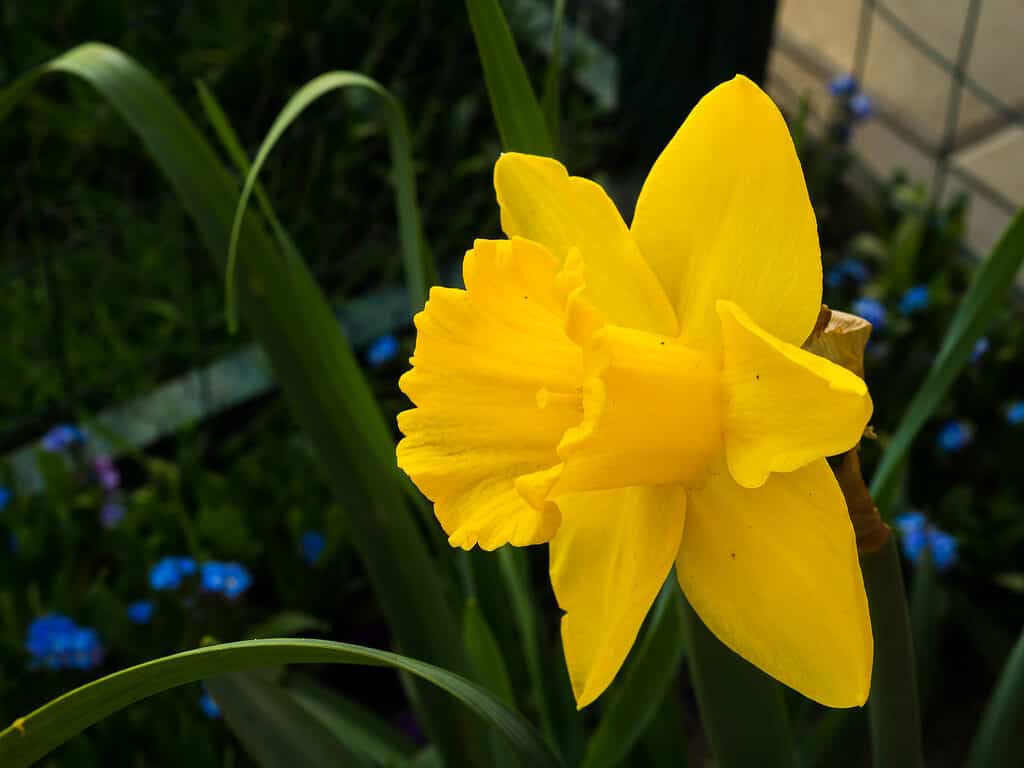
Daffodil divisions make identifying varieties such as trumpet daffodils easier for gardeners of all experience levels.
©monikozi/Shutterstock.com
When Were the 13 Daffodil Divisions Introduced?
The current daffodil divisions didn’t exist in 1884 at the first conference hosted by the RHS. However, that’s also the year the RHS formed its Narcissus and Tulip Committee, which today is the RHS Bulb Committee.
The RHS Narcissus and Tulip Committee eventually introduced the initial list of daffodil divisions in 1908 for use with gardening and flower show classifications. At first, there were only seven divisions, but RHS added more over the years. By 1998, RHS expanded the list of daffodil divisions to 13 in total.
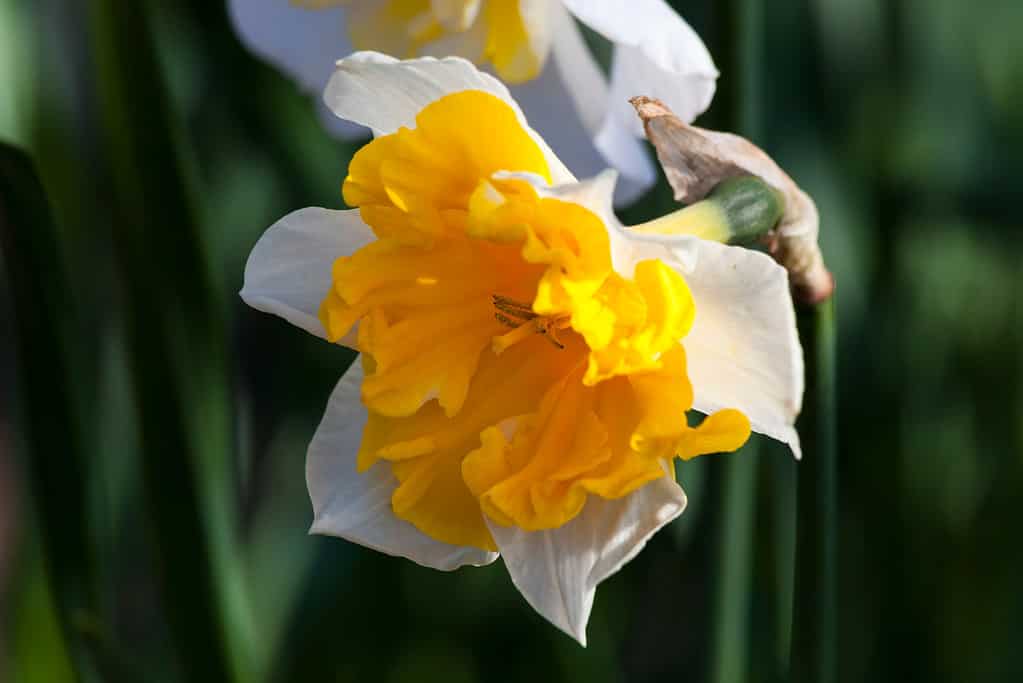
The ‘Orangery’ cultivar belongs to division #11a for split-cupped collar daffodils.
©Tony Baggett/Shutterstock.com
The 13 Daffodil Divisions in Order
Before we dive into each division and its details, here’s the full list of 13 daffodil divisions used to identify these plants:
- Division #1: Trumpet Daffodils
- Division #2: Large-Cupped Daffodils
- Division #3: Small-Cupped Daffodils
- Division #4: Double Daffodils
- Division #5: Triandrus Daffodils
- Division #6: Cyclamineus Daffodils
- Division #7: Jonquilla Daffodils
- Division #8: Tazetta Daffodils
- Division #9: Poeticus Daffodils
- Division #10: Bulbocodium Daffodils
- Division #11a: Split-Cupped Collar Daffodils
- Division #11b: Split-Cupped Papillion Daffodils
- Division #12: Other Daffodil Cultivars
- Division #13: Daffodils Categorized Only by Botanical Name
Now let’s look at the traits of each division and what makes each type of daffodil unique.
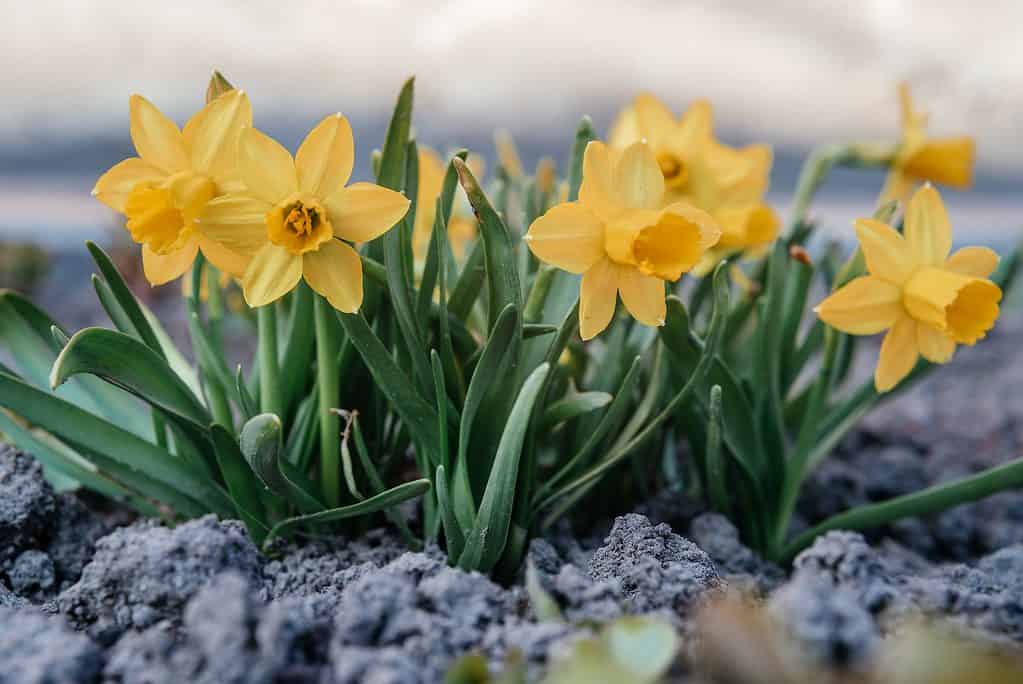
Miniature or dwarf daffodils can be found in multiple daffodil divisions.
©Marinesea/Shutterstock.com
Miniature vs. Standard Size Daffodils
Some daffodil divisions include both miniature and standard-size plants. So check each cultivar’s grower or plant supplier information to determine the daffodil size at maturity.
In general, miniature daffodils are smaller plants with smaller blooms than standard daffodils. And a large percentage of miniature daffodils grow less than or just above a foot tall.
Division #1: Trumpet Daffodils
If you’re familiar with trumpet daffodils, you’ll know why millions of daffodil fans love them. In addition to their big center cups, trumpet daffodils are frilly, make beautiful cut flowers, and provide a lovely scent to garden beds.
The trumpet daffodil belongs in division #1 and has the following two main traits:
- One bloom per plant stem.
- A trumpet-shaped cup (corona) that grows as long as or longer than the flower petals.
Trumpet daffodils come in many different colors and can have a variety of cup shapes, including long and thin or wide and flared.
When choosing a trumpet daffodil to plant, consider one of these popular cultivars:
- Narcissus ‘Dutch Master’ — An all-yellow daffodil.
- Narcissus ‘Mount Hood’ — A daffodil with white petals and a yellow cup that matures to white.
Trumpet daffodils have a traditional look many people think of when picturing daffodils. But they’re also a lot like large-cupped daffodils. Do you know the differences between the two? Keep reading to find out!
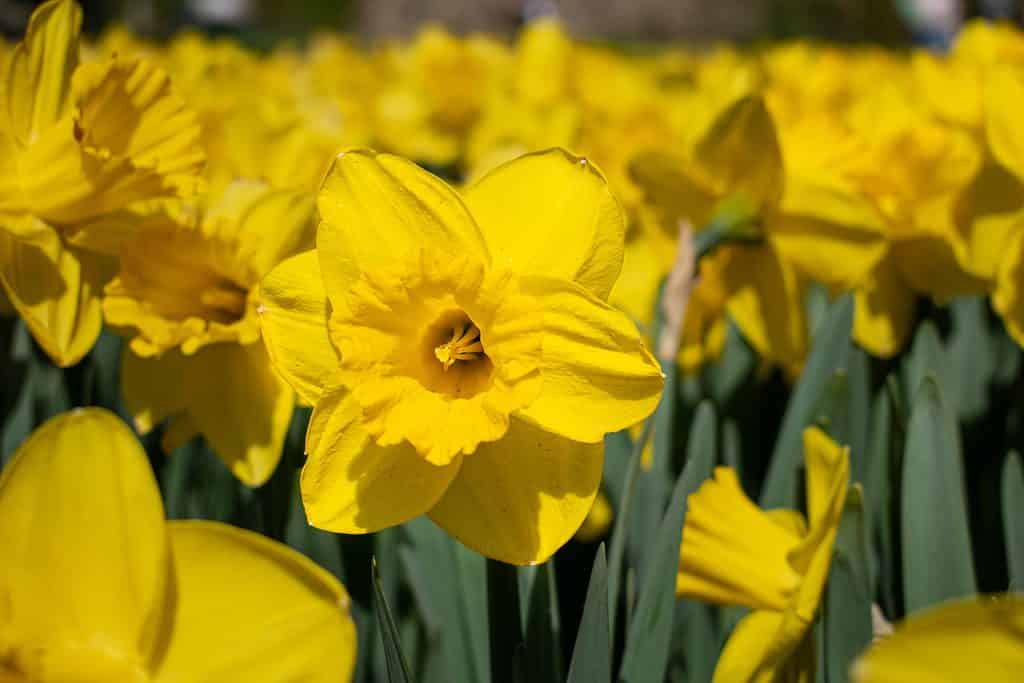
‘Dutch Master’ is a golden yellow trumpet daffodil with frilly center cups.
©Dajbog Nicoleta/Shutterstock.com
Division #2: Large-Cupped Daffodils
Large-cupped daffodils look a lot like trumpet daffodils, but the main difference is the size of their cups. For example, trumpet daffodil cups can grow longer than their petals, but that’s not true for large-cupped daffodils.
The official division #2 traits used to classify large-cupped daffodils are the following:
- One flower per stem.
- Cup (corona) lengths are greater than one-third but less than or equal to their petals.
Also, similar to trumpet daffodils, large-cupped daffodils can have varying cup shapes, including flared or narrow ones. These showy daffodils come in several colors and bicolor combinations, like yellow and orange.
Popular large-cupped daffodils for home gardens include these cultivars:
- Narcissus ‘Accent’ – A daffodil with cream and yellow petals with orange cups.
- Narcissus ‘Carlton’ – A golden yellow daffodil.
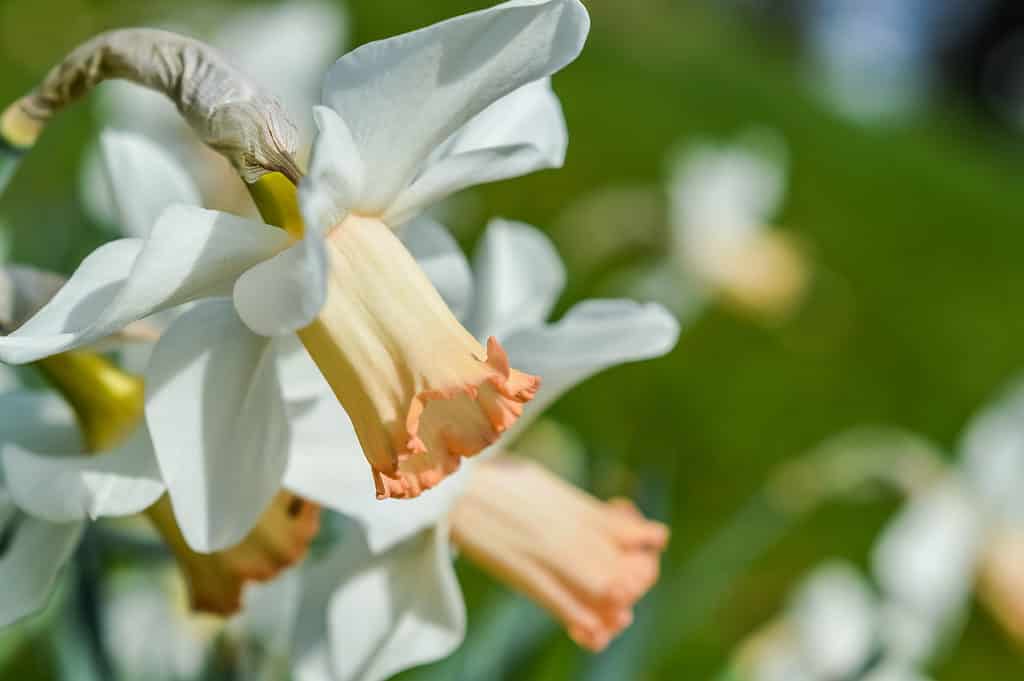
The ‘Accent’ cultivar is a large-cupped daffodil that belongs in division #2.
©sebastianosecondi/Shutterstock.com
Division #3: Small-Cupped Daffodils
You guessed it — small-cupped daffodils have small cups! Though they have one bloom per stem like a trumpet or large-cupped daffodil, these flowers have noticeably smaller coronas.
But smalled-cupped daffodils aren’t the only narcissus flowers with small cups. For example, poeticus and tazzeta daffodils have them, too. So it’s important to note the following official traits of division #3 small-cupped daffodils.
Small-cupped daffodils are identified by:
- One bloom per stem.
- A small cup (corona) that grows up to one-third of the flower petals’ (perianth segments) length.
Many small-cupped daffodils are bicolor varieties and have medium-sized flowers. The following small-cupped daffodil cultivars are standard-size plants that grow 1-2 feet tall:
- Narcissus ‘La Riante’ — A bicolor daffodil with white petals and orange cups.
- Narcissus ‘Moon Shadow’ — A daffodil with white petals and light yellow cups.
So far, the first few daffodil divisions all have similar flowers. However, the beautiful plants of division #4 sometimes look more like carnations or peonies than daffodils!
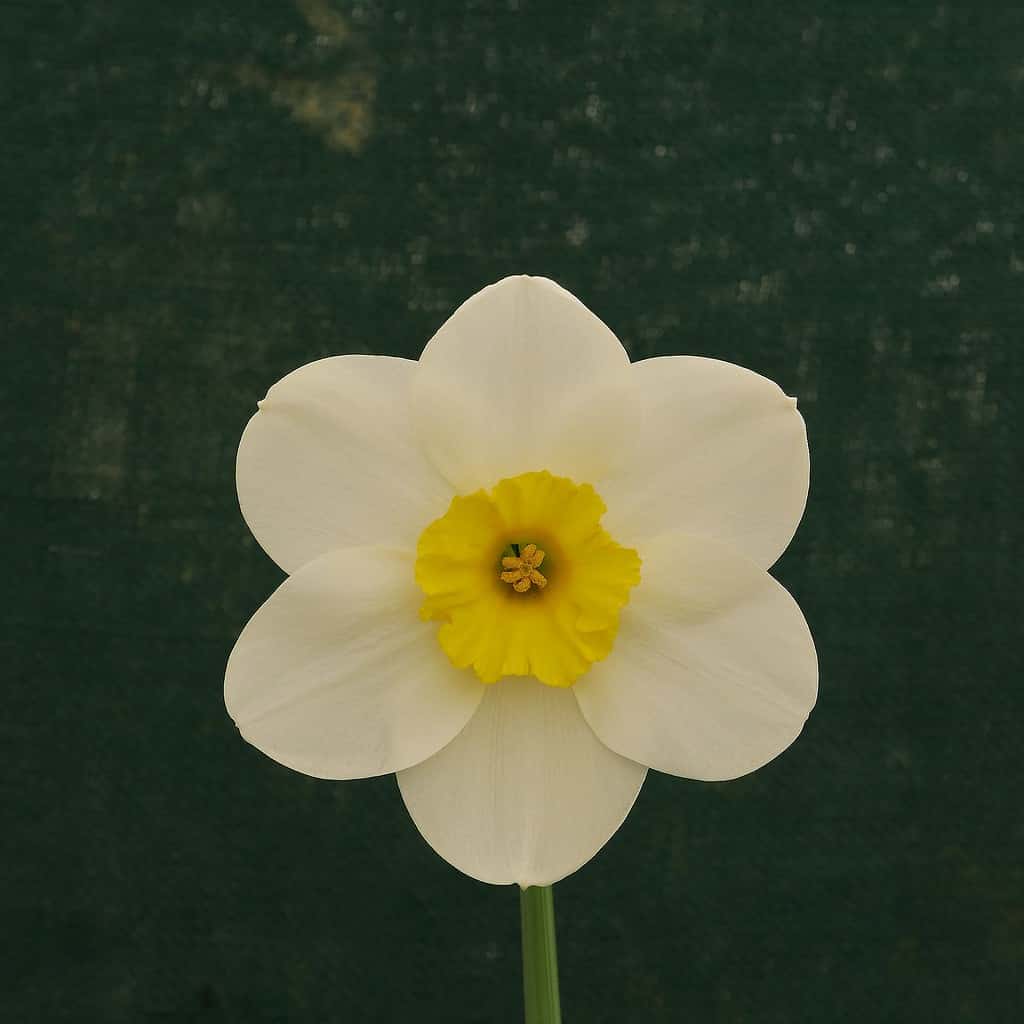
‘Moon Shadow’ is a division #3 small-cupped daffodil with white petals and a yellow cup.
©Joe Kuis/Shutterstock.com
Division #4: Double Daffodils
Double daffodils are a favorite among growers because these flowers have double the petals compared to most other daffodil divisions. And their cup segments are doubled, as well. So these super fluffy daffodils sometimes get mistaken for similar flowers like carnations, gardenias, or peonies.
Here are the characteristics for division #4 that identify double daffodils:
- One or more double blooms per stem.
- Double daffodil flowers have double the number of petals as other daffodils or have double the cups segments or both.
Though not an official characteristic of all double daffodils, most of these fluffy flowers also have a wonderful scent that’s either spicy or sweet.
Some tried-and-true double daffodil cultivars include the following:
- Narcissus ‘Flower Drift’ — An all-white double daffodil.
- Narcissus ‘Golden Ducat’ — An all-yellow double daffodil.
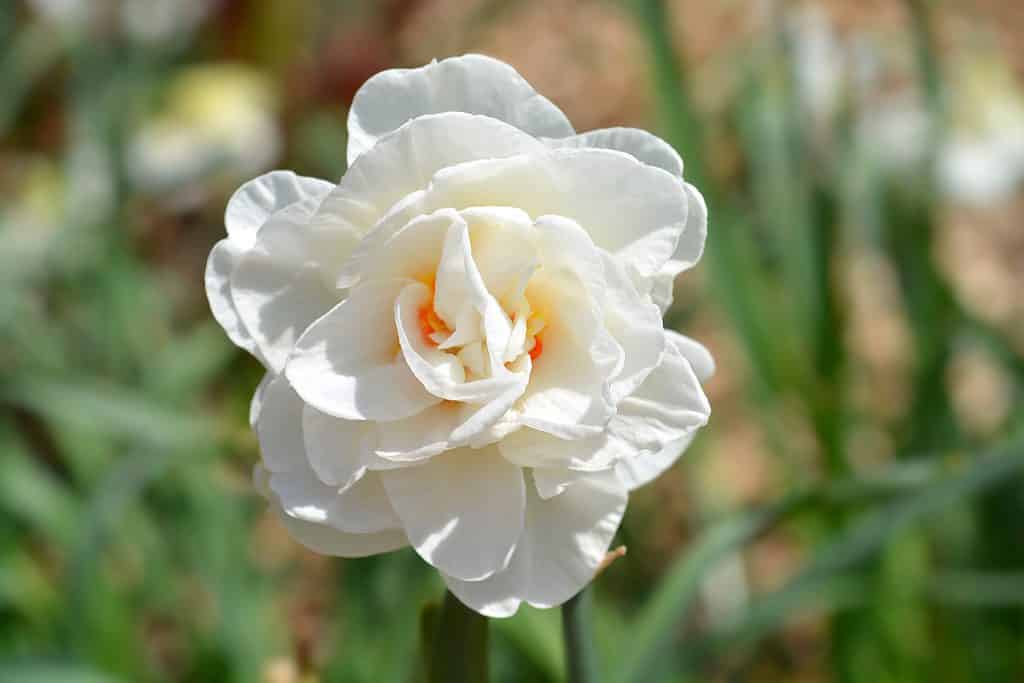
The ‘Flower Drift’ cultivar is extra fluffy because it’s a double daffodil.
©Nahhana/Shutterstock.com
Division #5: Triandrus Daffodils
Triandrus daffodils are usually miniature plants with multiple blooms per stem and magnificent fragrances. These division #5 daffodils are also often used to create new and exciting hybrid flowers.
Official traits of triandrus daffodils include:
- Two or more pendant blooms per stem.
- Triandrus daffodils also have reflexed petals (perianth segments), which means the petals are at least slightly inverted.
In addition, triandrus daffodils often come in muted tones of yellow, white, or bicolor. Their small swinging pendant flowers in soft colors make triandrus flowers a lovely sight to behold!
For triandrus cultivar suggestions, try these two beautiful varieties:
- Narcissus ‘Hawera’ — A pale yellow triandrus daffodil.
- Narcissus ‘Ice Wings’ — A soft white triandrus daffodil.
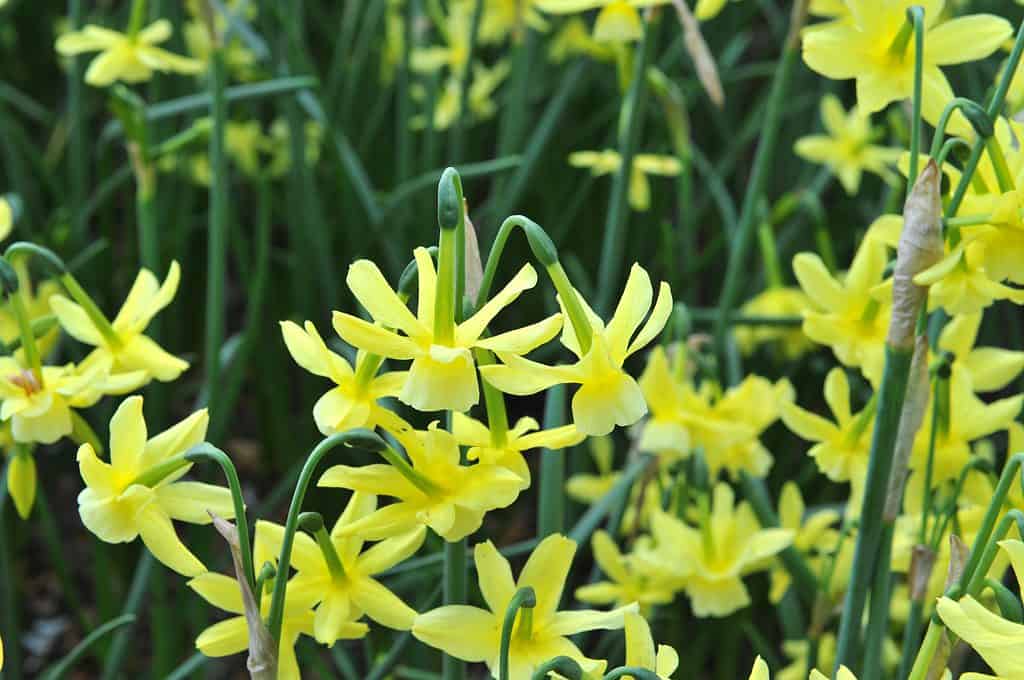
The ‘Hawera’ cultivar is a triandrus daffodil that belongs to division #5 and has strongly reflexed petals.
©Sergey V Kalyakin/Shutterstock.com
Division #6: Cyclamineous Daffodils
The Cyclamineous daffodil belongs to division #6 and is identified by the following special traits, according to the RSH System of Classification:
- One bloom per plant stem.
- Flowers with strongly-reflexed petals.
- Flowers with short necks that angle downward from the stem.
Like triandrus daffodils of division #5, cyclamineus daffodils are usually miniature plants with a strong and pleasing scent. And the trumpets or center cups of these plants are frilly and prominent! In addition, this daffodil’s cups are either long and narrow or short and wide, depending on the cultivar.
Are you on the lookout for gorgeous cyclamineus daffodil plants? You might love these popular cultivars for your home garden:
- Narcissus ‘Jack Snipe’ — A bicolor cyclamineous daffodil with white petals and yellow cups.
- Narcissus ‘Jetfire’ — Also a bicolor cyclamineous daffodil with yellow petals and orange cups.
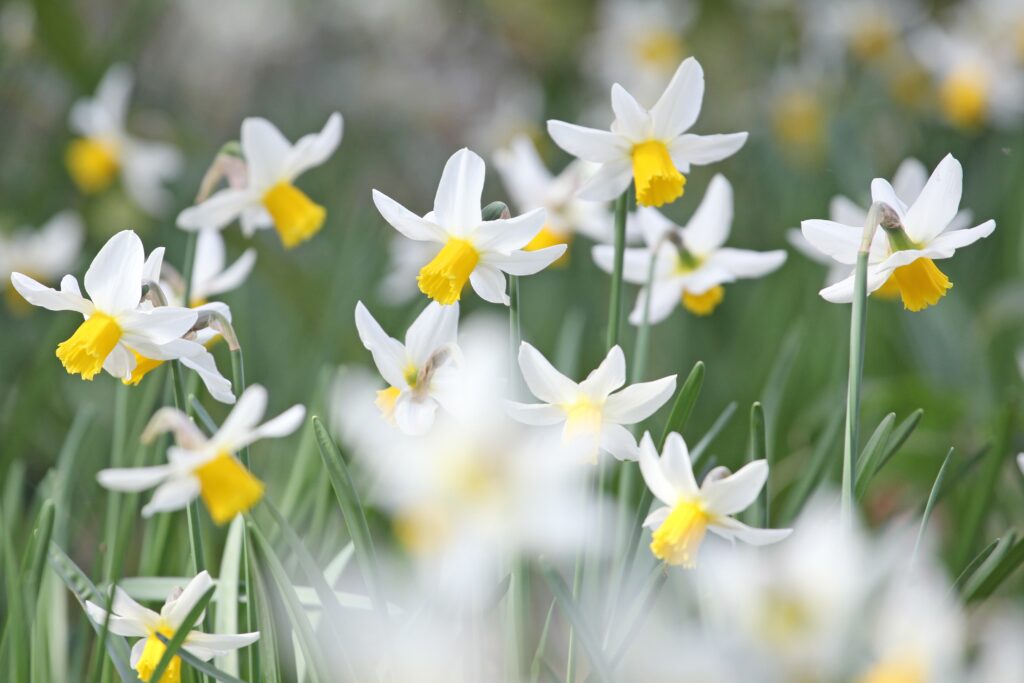
Cyclamineous daffodils like ‘Jack Snipe’ are also miniature daffodils.
©Alex Manders/Shutterstock.com
Division #7: Jonquilla Daffodils
Jonquilla daffodils, or jonquils, make up division #7 of the 13 daffodil divisions. So if you were wondering if jonquils are also daffodils, the answer is yes! But not all daffodils are jonquils, of course. Only the daffodils in division #7 have the honor of the jonquilla title.
The jonquil daffodil also has specific traits defined by the division #7 classification. Those traits are:
- Up to eight blooms per plant stem, though 1-5 flowers per stem is most common.
- Jonquil petals (perianth segments) can be either spreading or reflexed.
- The jonquilla cups (called coronas) are flared, shaped like funnels, or shaped like cups.
- Jonquilla blooms usually grow wider than they grow long.
- Jonquilla daffodils produce a strong and delightful scent.
Two of the most beloved jonquilla daffodil cultivars for home garden plots and pots include the following beautiful plants:
- Narcissus ‘Silver Smiles’ — A bicolor jonquilla daffodil with soft white petals and pale yellow cups that mature to white.
- Narcissus ‘Quail’ — A golden yellow jonquilla daffodil.
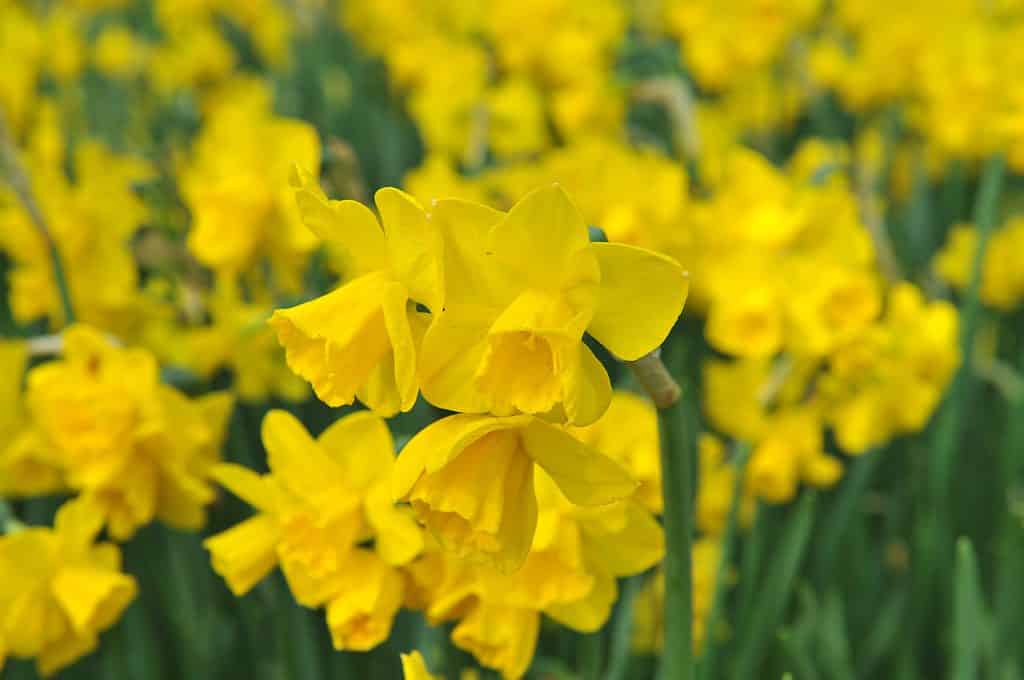
A popular type of jonquilla daffodil is the golden yellow ‘Quail’ cultivar.
©Sergey V Kalyakin/Shutterstock.com
Division #8: Tazetta Daffodils
One thing that makes tazetta daffodils special is how many small-cupped flowers they produce! According to their classification as division #8 daffodils, tazettas produce anywhere from 3-20 flowers per plant stem. So you get a bounty of blooms with this daffodil division.
Here are the official traits used to identify tazetta daffodils:
- Produce 3-20 flowers per plant stem.
- Petals (perianth segments) are spreading rather than reflexed.
- Tazetta flowers are usually fragrant.
The tazetta daffodil is also called a paperwhite daffodil, which usually references the white cultivars in this division. There are also bicolor tazetta daffodils, and some (no matter their flower color) have double blooms.
In addition, tazettas are usually miniature daffodils grown as annual flowers.
Tazetta daffodils are hardy in Zones 8-11, so they prefer warmer climates to other types of daffodils. And here are a couple of the best tazetta cultivars for warm climates in the U.S.:
- Narcissus ‘Ziva’ — A paperwhite (white petals and cups) tazetta daffodil with a peppery scent.
- Narcissus ‘Avalanche’ — A bicolor tazetta daffodil with white petals and bright yellow cups.
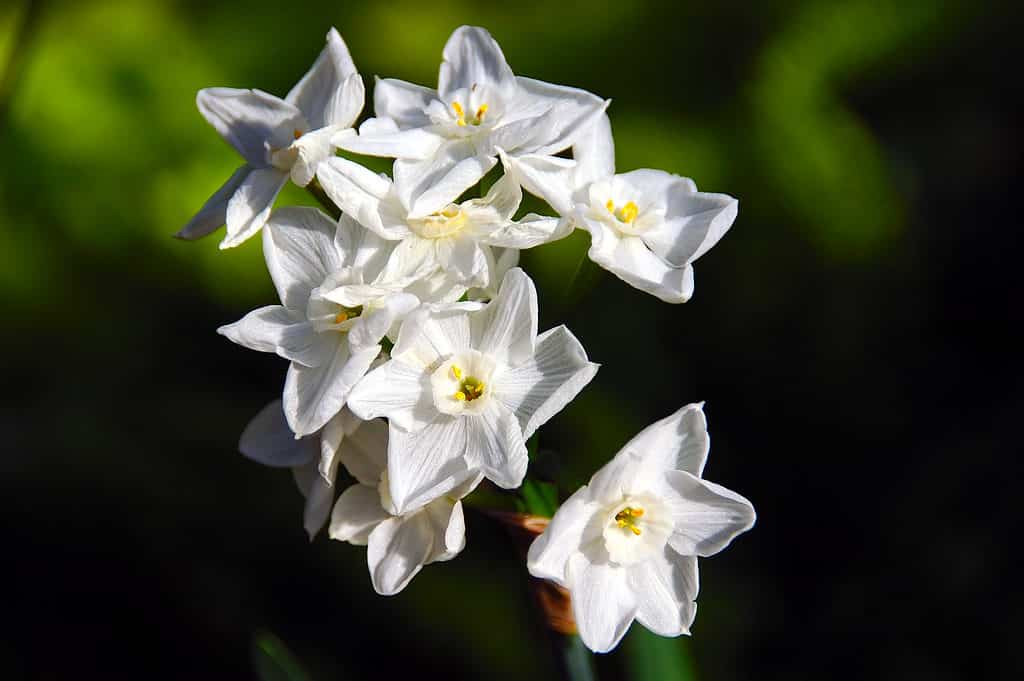
The ‘Ziva’ cultivar is a paperwhite tazetta daffodil.
©iStock.com/akit
Division #9: Poeticus Daffodils
Also called the poet’s daffodil, poeticus daffodils are famous in historical literature and mythology. And its unique look also makes poeticus a favorite daffodil among modern growers who love this flower’s tiny multi-colored cups.
All poeticus or division #9 daffodils have the following characteristics designated by the Royal Horticultural Society:
- Daffodils with short or disc-shaped cups (coronas).
- Flowers with two anther lengths.
- Center cups with green, chartreuse, or yellow centers and an orange-red rim.
- Center cups that grow one-fifth or less the length of the petals.
- Petals (perianth segments) that are all-white.
- Pleasingly fragrant plants.
Two gorgeous and reliable poeticus daffodil cultivars include the following:
- Narcissus ‘Actaea’ — A multi-colored poeticus daffodil with white petals and yellow cups with red edges.
- Narcissus ‘Sea Green’ — Another multi-colored poeticus daffodil with white petals, plus yellow and green center cups that have orange rims.
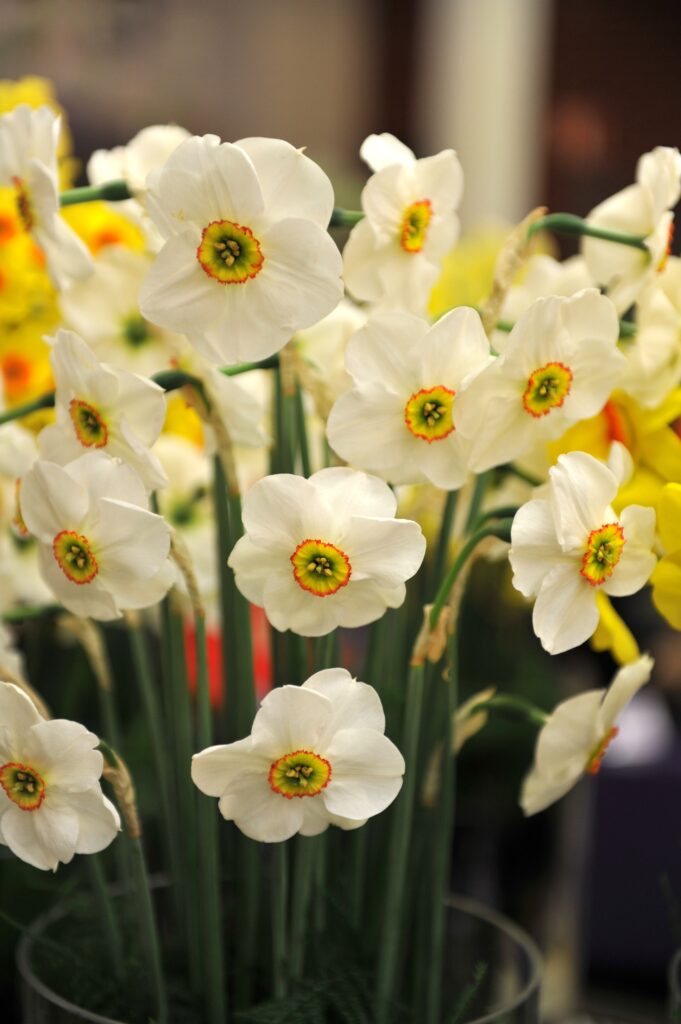
The ‘Sea Green’ poeticus daffodil has white petals with green, yellow, and red center cups.
©Sergey V Kalyakin/Shutterstock.com
Division #10: Bulbocodium Daffodils
The bulbocodium, or division #10 daffodil, has a unique look compared to other daffodils. Mainly, this flower’s cup is much bigger and more prominent than its tiny, narrow petals. So bulbocodium daffodils might be one of the easiest daffodil types to recognize.
According to the RHS Classification System, these are the characteristics of bulbocodium daffodils:
- One bloom per plant stem.
- Their flower cup is significantly larger than their petals.
- Bulbocodium flowers also feature a curved filament and style.
Like tazetta and cyclamineous daffodils, division #10 plants are usually miniature and fragrant. Additionally, bulbocodium daffodils are some of the earliest bloomers of all daffodil varieties. For example, there are bulbocodium daffodils that produce flowers in late winter in many U.S. Hardiness Zones.
Need some suggestions for stunning bulbocodium cultivars? You might enjoy growing the two beauties below!
- Narcissus ‘Golden Bells’ — An all-yellow bulbocodium daffodil.
- Narcissus ‘Mary Poppins’ — A cream and pale yellow bulbocodium daffodil.
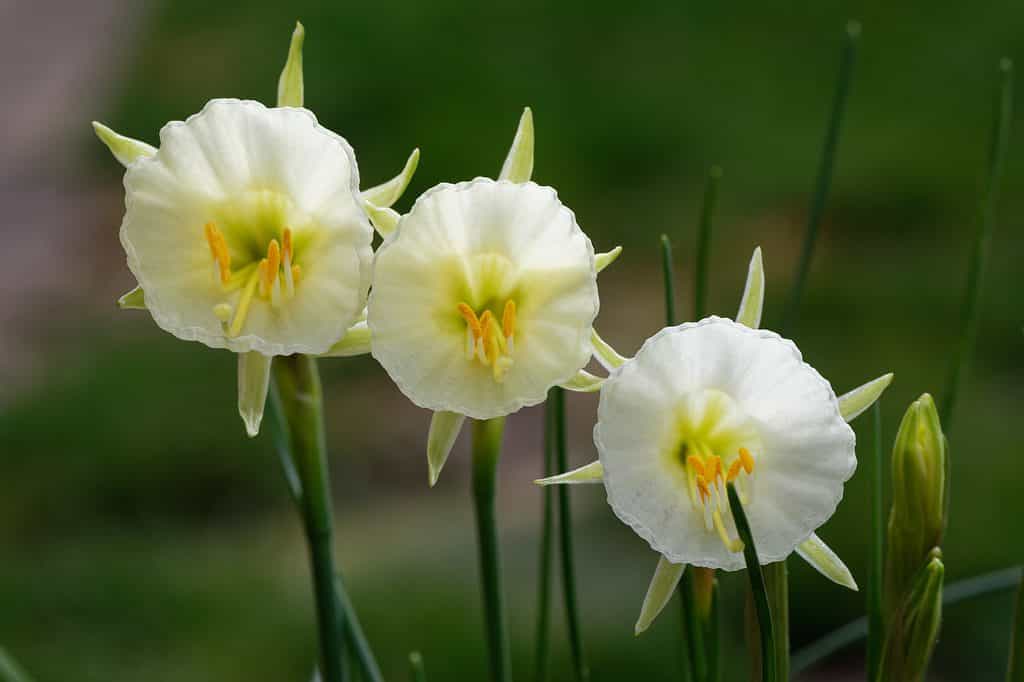
The ‘Mary Poppins’ cultivar is a miniature bulbocodium daffodil with a prominent cup and tiny petals.
©Walter Erhardt/Shutterstock.com
Division #11a: Split-Cupped Collar Daffodils
The split-cupped daffodils of division #11 have two categories:
- #11a: Split-Cupped Collar Daffodils
- #11b: Split-Cupped Papillion Daffodils.
First, split-cupped collar daffodils have these particular traits:
- Their cup (corona) is split.
- The split segments of the cup sit opposite the petals (perianth segments) in the flower.
- The segments of the cup are usually positioned in two whorls of three.
Their split-cup and petal positions make split-cupped collar daffodils look layered and fluffy. This look is why split-cupped daffodils (any variety) have the nickname butterfly daffodils because their cup and petal segments flutter in the breeze.
Some popular split-cupped collar daffodils for home gardens include the following:
- Narcissus ‘Mondragon’ — A bicolor split-cupped collar daffodil with yellow petals and an orange cup.
- Narcissus ‘Rainbow of Colors’ — A color-changing split-cupped collar daffodil with white petals and center cups that open in yellow, change to salmon, and then change again to pink.
Next, split-cupped papillion daffodils have slightly different characteristics. Keep reading to learn what they are!
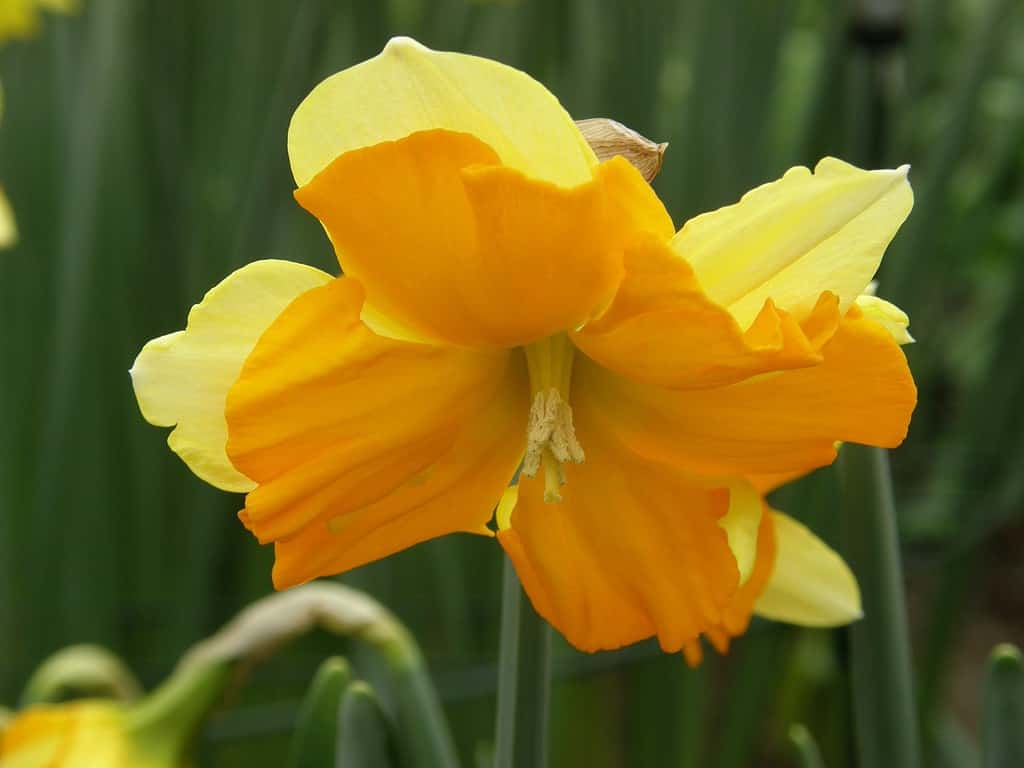
‘Mondragon’ is a bicolor split-cupped collar daffodil with yellow petals and bright orange split cup segments.
©Sergey V Kalyakin/Shutterstock.com
Division #11b: Split-Cupped Papillion Daffodils
The split-cupped papillion daffodil is also called a butterfly daffodil for its fluttery cup and petal segments. However, the placement of those segments makes this daffodil differ from the split-cupped collar variety.
Based on the RHS Classification System, the traits of split-cupped papillion daffodils are the following:
- This flower’s split-cup segments sit in an alternate position to the petals (perianth segments).
- The split-cup segments are also usually positioned in a single whorl of six.
Two split-cupped papillion daffodil cultivars known for their beauty and hardiness include the following:
- Narcissus ‘Dolly Mollinger’ — A bicolor split-cupped papillion daffodil with white petals and orange-yellow cups.
- Narcissus ‘Sorbet’ — Also a bicolor split-cupped papillion daffodil with white petals plus orange and yellow cups.
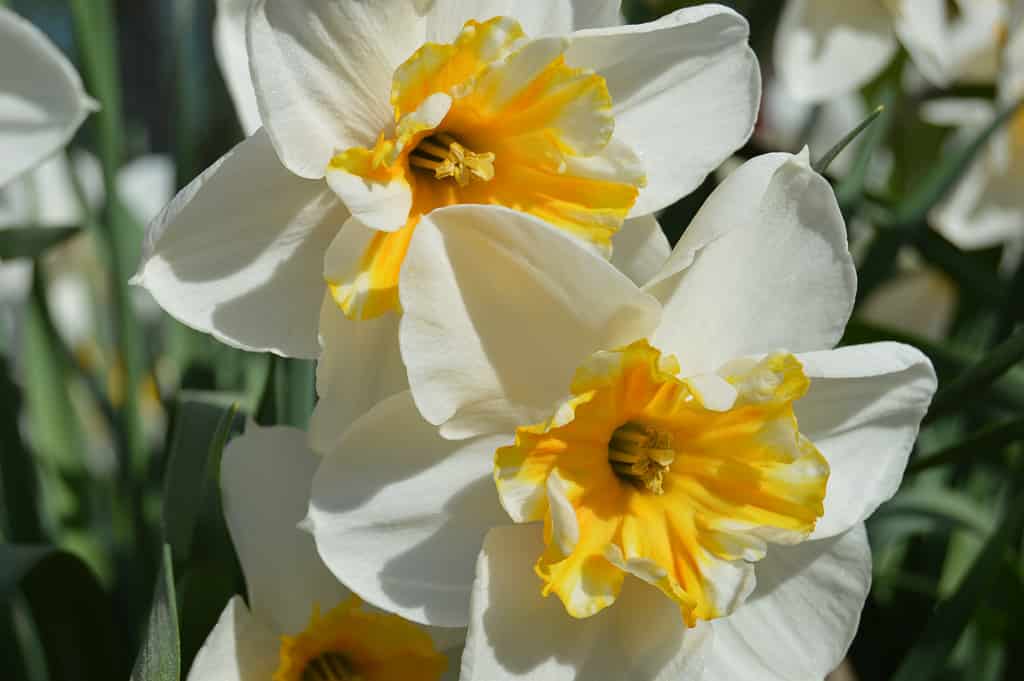
A popular split-cupped papillion daffodil for home gardens is the ‘Dolly Mollinger’ cultivar.
©dior2021/Shutterstock.com
Division #12: Other Daffodil Cultivars
Daffodils that belong in division #12 don’t fit the exact classifications of the other divisions. More specifically, many of these daffodils are inter-division hybrid plants.
In fact, one such example is the ‘Jumblie’ daffodil which belongs to division #12. ‘Jumblie’ is a hybrid created from pairing specific tazetta and cyclamineous daffodils. For this reason, ‘Jumblie’ is sometimes called a cyclataz daffodil.
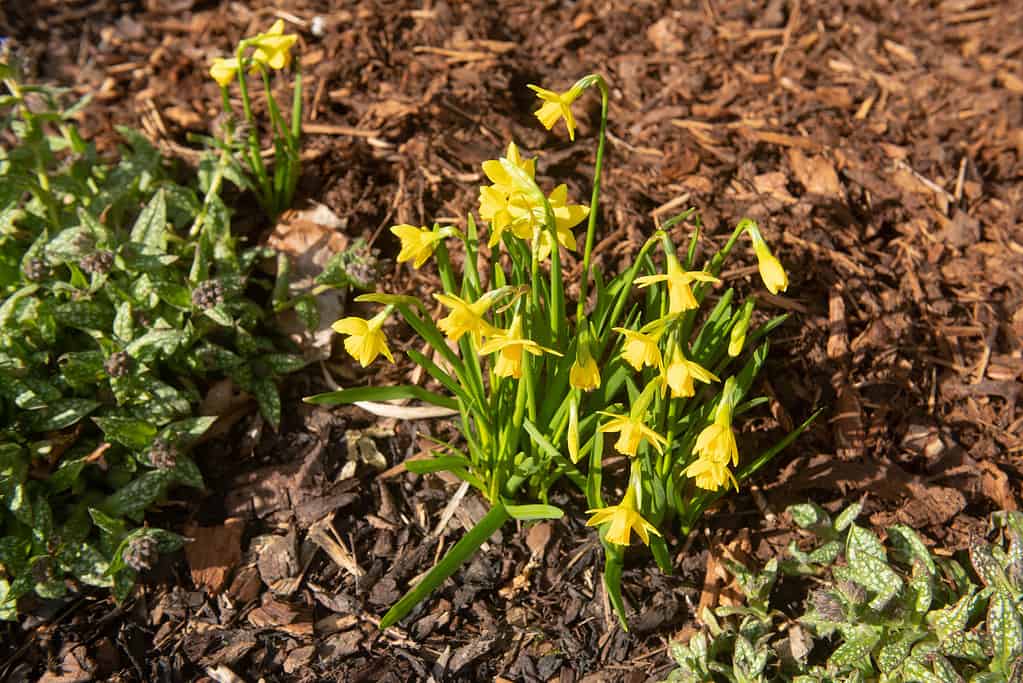
The ‘Jumblie’ daffodil is an inter-division hybrid that belongs to division #12.
©Peter Turner Photography/Shutterstock.com
Divisions #13: Daffodils Distinguished Only By Botanical Name
Finally, division #13 daffodils are the last division in the group. Division #13 flowers are classified solely by their botanical (scientific) name.
Many of the daffodils in this division are wild hybrids and variants. For example, Narcissus pseudonarcissus subsp. moschatus is a wild variety with the common name swan’s neck daffodil. It has an all-white flower with a large cup, which dangles elegantly like a pendant from its stem.
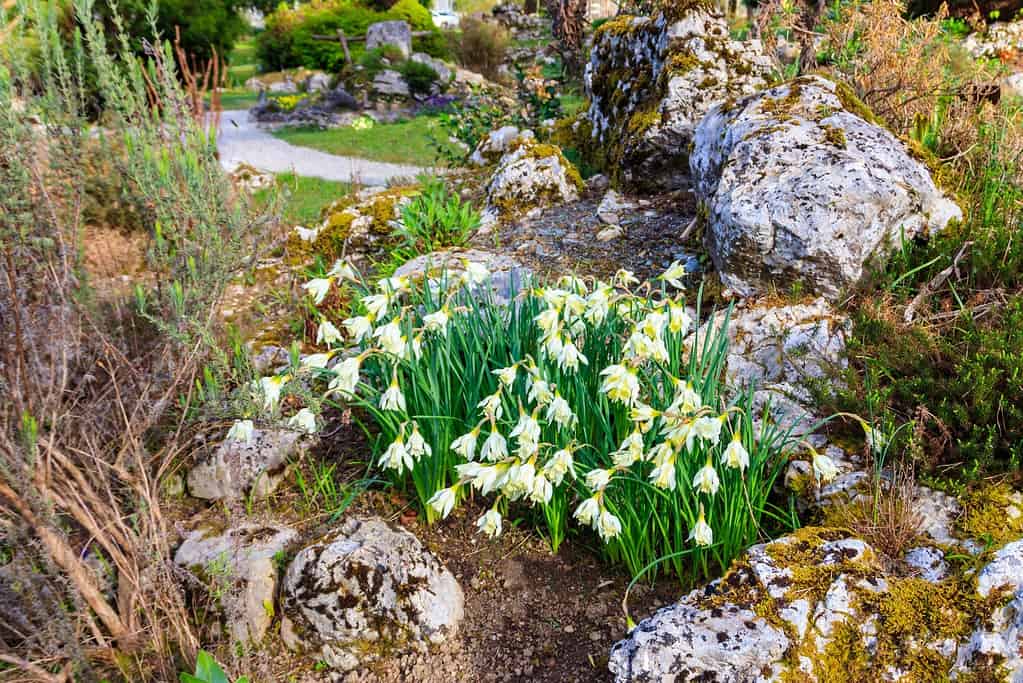
Swan’s Neck or
Narcissus pseudonarcissussubsp.
moschatusplants are division #13 daffodils.
©Olha Solodenko/Shutterstock.com
What Most Daffodils Have in Common
So you’ve learned about the differences between all of these daffodils, but what do they have in common? Most daffodils have similar growth habits and best practices for planting. So here are some similarities between most daffodil divisions:
- Yellow is the most common daffodil color, though white daffodils probably come in second.
- Daffodils have a center cup called a corona, though the size and shape can differ greatly between some varieties.
- Most daffodils bloom in the spring in the Northern Hemisphere, though some cultivars produce flowers in late winter.
- Daffodil plants bloom more quickly when grown from bulbs. This fact is because it takes up to five years for daffodils grown from seed to create bulbs mature enough to produce blooming plants.
- Most daffodils naturalize easily, which means they can thrive in areas (like meadows and fields) outside established garden beds.
- Daffodils are perennial plants that come back every year. However, separating and replanting daffodil bulbs every 5-10 years is essential to prevent overcrowding. Daffodils will produce fewer and fewer blooms the more crowded in the ground they become.
- Most daffodils need a period of dormancy in cold weather to produce blooming plants in the spring. This cold dormancy is why we plant most daffodil bulbs in the fall.
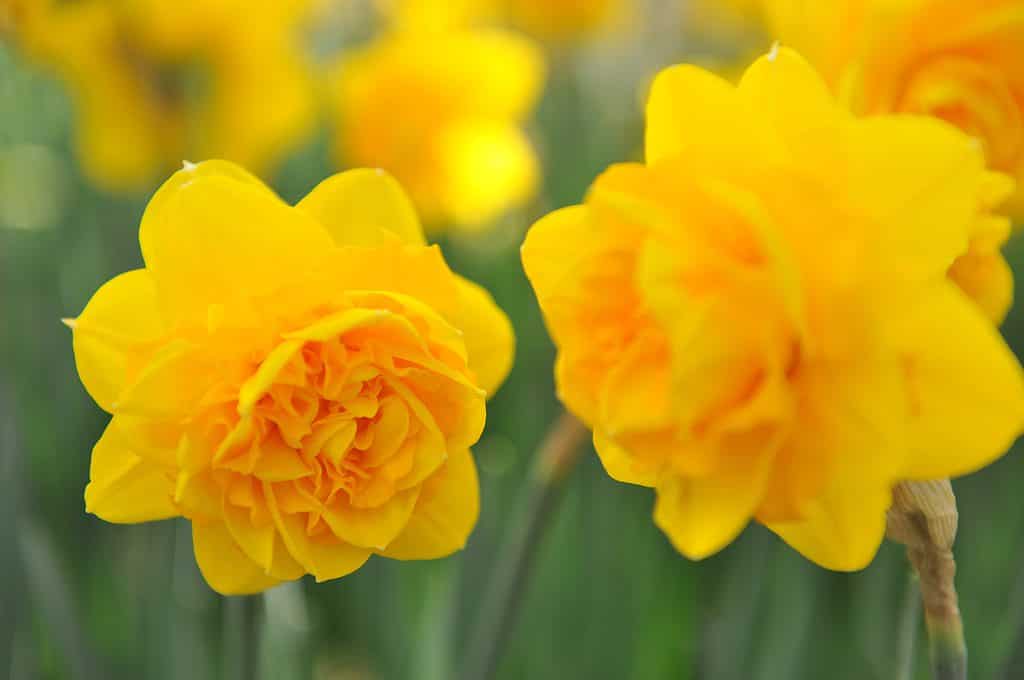
Though it’s hard to tell the difference because of their double segments, double daffodils have cups and petals.
©Sergey V Kalyakin/Shutterstock.com
Summary of 13 Daffodil Divisions, Explained
Here’s a recap of the 13 divisions of daffodils as defined by the Royal Horticultural Society Classification System that we took a look at.
| Division Number | Division | Popular Cultivars |
|---|---|---|
| Division #1 | Trumpet Daffodils | Narcissus ‘Dutch Master’ Narcissus ‘Mount Hood’ |
| Division #2 | Large-Cupped Daffodils | Narcissus ‘Accent’ Narcissus ‘Carlton’ |
| Division #3 | Small-Cupped Daffodils | Narcissus ‘La Riante’ Narcissus ‘Moon Shadow’ |
| Division #4 | Double Daffodils | Narcissus ‘Flower Drift’ Narcissus ‘Golden Ducat’ |
| Division #5 | Triandrus Daffodils | Narcissus ‘Hawera’ Narcissus ‘Ice Wings’ |
| Division #6 | Cyclamineus Daffodils | Narcissus ‘Jack Snipe’ Narcissus ‘Jetfire’ |
| Division #7 | Jonquilla Daffodils | Narcissus ‘Silver Smiles’ Narcissus ‘Quail’ |
| Division #8 | Tazetta Daffodils | Narcissus ‘Ziva’ Narcissus ‘Avalanche’ |
| Division #9 | Poeticus Daffodils | Narcissus ‘Actaea’ Narcissus ‘Sea Green’ |
| Division #10 | Bulbocodium Daffodils | Narcissus ‘Golden Bells’ Narcissus ‘Mary Poppins’ |
| Division #11a | Split-Cupped Collar Daffodils | Narcissus ‘Mondragon’ Narcissus ‘Rainbow of Colors’ |
| Division #11b | Split-Cupped Papillion Daffodils | Narcissus ‘Dolly Mollinger’ Narcissus ‘Sorbet’ |
| Division #12 | Other Daffodil Cultivars | ‘Jumblie’ daffodil |
| Division #13 | Daffodils Categorized Only by Botanical Name | Narcissus pseudonarcissus subsp. moschatus |
The 13 Daffodil Divisions Make Identification Easier
Though it takes time to learn which types of daffodils belong in each, the RHS daffodil divisions make plant identification easier for growers and enthusiasts. And we can imagine it’s fun for daffodil breeders to see the division traits combined or changed in the new daffodil hybrids they create!
We hope these 13 daffodil divisions explained help you identify and enjoy more varieties of daffodils for years to come.
The photo featured at the top of this post is © Kazakov Maksim/Shutterstock.com
Thank you for reading! Have some feedback for us? Contact the AZ Animals editorial team.






